Meredith Allard's Blog, page 28
August 9, 2016
The Joy of Art Journaling
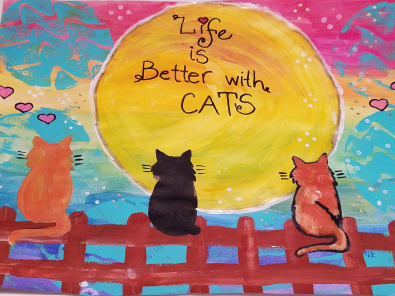
I’ve shown this one of my three cats before, but it’s one of my favorites. I found the shape of the cats on Pinterest, then made a stencil of it with card stock.
I fell in love with art as a sophomore in college when I happened to take an art history class. I didn’t know much about art then, but the class fulfilled a humanities requirement and it had open seats so I grabbed it. The class covered the time period from the earliest cave paintings through the Roman Empire. I remember the professor seemed so ancient to my 19 year old eyes, but was probably in his mid forties, not old at all now that I’m in my mid forties myself. He was a slight, slender man in his khaki pants, polo shirts, and sweater tied around his neck though it was summer in the San Fernando Valley in California. I don’t think I’ve ever seen anyone as excited about their subject as that professor was. He spoke with such enthusiasm, describing the hieroglyphics inside the Egyptian pyramids as though they were indeed messages handed down by the gods. I remember the professor leading a class expedition to the J. Paul Getty Museum, and I remember the feeling of complete enchantment as I studied the Greek statues and pottery. I found the professor, and his subject, endearing, and it was because of that class I developed a lifelong love for art in all its forms.
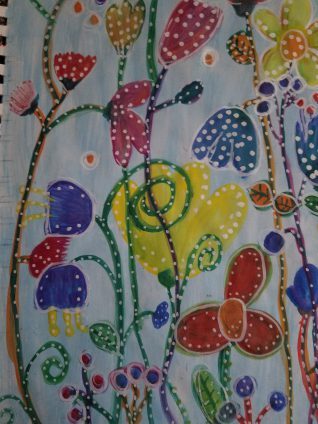
My first attempt at watercolors. I’ve since learned that you’re supposed to paint watercolors on wet paper. I like the whimsical look because it’s not supposed to be realistic.
As much as I love to visit museum exhibitions of the great artists, I never thought of myself as much of an artist. I was a writer, so I had to content myself with the fact that I got my creative expression from writing. A number of years ago I dabbled in painting with acrylics, but I really didn’t know what I was doing. I tried to take a painting class at the extension university where I was teaching creative writing, but the teacher wasn’t all I hoped she would be. She was a short French woman with the oddly elfin look of Dobby from the Harry Potter books. Her dyed jet-black hair was cut into an ear-length 1920s flapper’s bob and she wore huge round black glasses that took up the whole of her face. She tottered around the classroom shrugging at the students’ paintings the way only the French can. There was no instruction. There were no directions. She put some flowers in a vase on a stool at the front of the classroom and told us to paint what we saw. That was it. I looked around and saw students painting, but I didn’t even know where to start. I had never taken an art class. Yes, I loved to look at paintings, but looking and painting are two very different things. I started painting the flowers in the vase the best I could. Finally, Dobby stopped besides me and shrugged. “You are supposed to paint what you see,” she said. “This is what you see?”
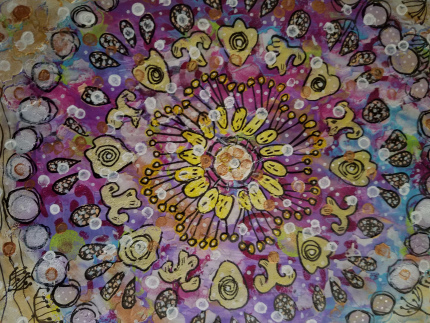
This one is kind of busy but I love the colors peeking through. I was using molding paste for the first time and got a little carried away.
“Yes” was the only answer that seemed appropriate. She shrugged again and moved on. A little while later she stopped near me again.
“Why is your canvas so small?” she asked. Now it was my turn to shrug (I’m French too, you know). I didn’t remember there being a canvas size requirement in the class materials list, I said. Dobby opened her arms wide. “If you want to learn to paint, you paint big!”
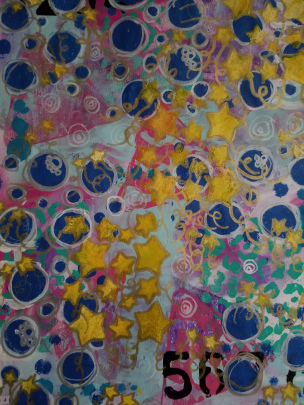
For this one I was trying out some new stencils I had just bought. Stencils are great for someone like me who doesn’t draw too well.
I told her the truth. I didn’t think I was going to learn how to paint from her if she didn’t give us any instruction. I was a complete beginner and knew nothing about painting. Her only response was “Hmpf!” as she tottered away. Another student next to me said that was just the way the teacher was. I grabbed my materials, left the room, and got a refund for the money I paid for the class. I practiced a little on my own, but then decided I wasn’t good at it because I didn’t know what I was doing so I stopped painting. I still considered myself a wanna-be artist, but I limited my non-writing artistic experiences to watching craft shows on TV.
Last year I started coloring, which I enjoy. It’s stress free because someone else has done the drawing. All I have to do is choose which colors I’m going to use and have fun. Then earlier this summer I was watching one of my favorite craft shows, Scrapbook Soup on PBS with Julie Fei-Fan Balzer, and she had a guest on who talked about art journaling. Art journaling? What’s this? Certainly, I knew what journaling was. Like most writers, I’ve been keeping a journal for years, but art journaling was something new to me.
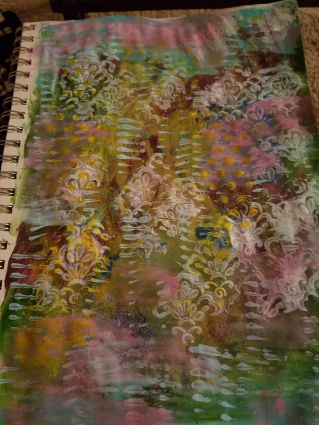
This is one of the first art journal pages I did. I was just playing around slapping some paint around the page.
If you’re not familiar with art journaling, it’s really the same as writing journaling except you’re using art supplies like colored pencils, paints, stencils, and stamps. Just as with writing journaling, art journaling is about the process and not about the finished product. When we keep writing journals we don’t worry about what we’re writing—we’re just writing. In Writing Down the Bones, Natalie Goldberg calls it writing practice. It’s the same with art journaling. It’s art practice. We’re not trying to create completed pieces of artwork for display. We’re playing with the supplies, trying out different paints and different styles and different color combinations, not worrying about the final result. We’re doing it just for the enjoyment. You can art journal on whatever paper you have handy—a bound journal, a composition book, even junk mail, old books, or magazines. You need only a few basic materials to get started. You don’t need to take art classes. It’s the same learning by doing mentality that helped me become a writer, and since no one is going to see what’s in my art journal but me, I don’t have to worry about some little wide-rimmed Dobby hovering over my shoulder shrugging as if I had no business even passing an art supply store.
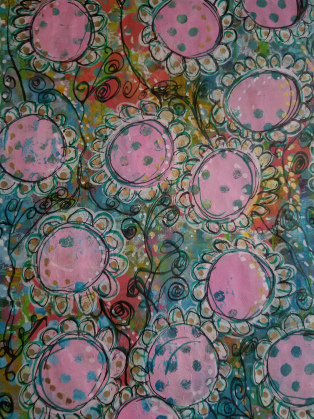
Here are some circles I turned into easy flowers.
With my interest in art journaling piqued, I began watching videos on YouTube. Mimi Bondi’s videos are great. Mimi is a French woman living in Australia, and she’s nothing like Dobby. In fact, she’s exactly the opposite. Her art is all about having fun. She’s the one who taught me that art journaling should be about playing as if you were a kid again. She spreads the paint for the background on her pages with her fingers, and now I do the same. If you’re interested in art journaling, check out Mimi’s videos. There are a whole lot of great art journaling examples on YouTube. I found a wealth of inspiration from Pinterest too since there are thousands of examples of art journal pages to see and learn from.
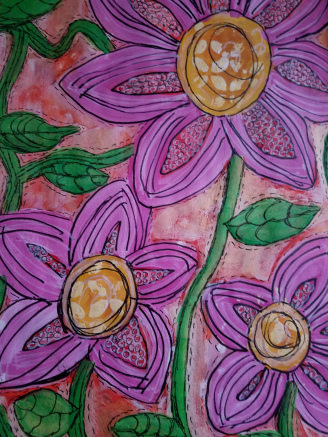 When I began art journaling, I started slowly, buying some cheap acrylic paint at the discount store, and I already had a pretty good stash of colored pencils, crayons, and markers because of my coloring. I had an old sketch book from the Dobby days when I tried to paint the first time, and that became my art journal. Now that I’ve been art journaling for a couple of months I bought myself more acrylic paints, and I love stencils because I don’t have to worry about my drawing skills. A lot of art journalists use stamps, but stamps are expensive and I haven’t gotten there yet. You can make your own stamps, but I haven’t tried it. I’m happy with my acrylic paints, colored pencils, and stencils. I’ve also started doodling (there are many easy to draw examples of doodles on Pinterest). I added a few paint markers to my stash, and I had a box of patterned scrapbook paper because I’ve created scrapbooks on occasion. Art journaling is simply about playing with what you have and allowing yourself the freedom to express yourself in whatever way you feel in the moment.
When I began art journaling, I started slowly, buying some cheap acrylic paint at the discount store, and I already had a pretty good stash of colored pencils, crayons, and markers because of my coloring. I had an old sketch book from the Dobby days when I tried to paint the first time, and that became my art journal. Now that I’ve been art journaling for a couple of months I bought myself more acrylic paints, and I love stencils because I don’t have to worry about my drawing skills. A lot of art journalists use stamps, but stamps are expensive and I haven’t gotten there yet. You can make your own stamps, but I haven’t tried it. I’m happy with my acrylic paints, colored pencils, and stencils. I’ve also started doodling (there are many easy to draw examples of doodles on Pinterest). I added a few paint markers to my stash, and I had a box of patterned scrapbook paper because I’ve created scrapbooks on occasion. Art journaling is simply about playing with what you have and allowing yourself the freedom to express yourself in whatever way you feel in the moment.
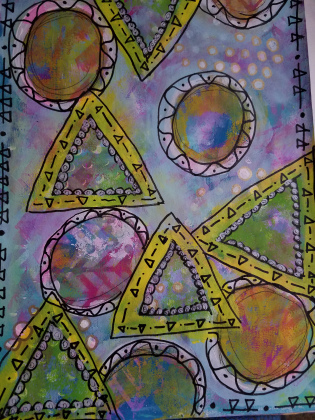
My first attempt with mini gelli plates.
Now, if you’re anything like me and have suffered from compare-itis, you’ll find it’s very easy to fall back into that trap when art journaling. Many of the people who make art journaling videos on YouTube or post their artwork on Pinterest are professional artists, so it’s very easy to look at their examples and think, “Well, I suck. What’s the point?” But that goes against the very purpose of art journaling. You need to look at the examples as what they are—examples—and then do what you can do in that moment. You can make your art journal pages look however you want—you can make them more like scrapbook pages, calendar pages, bullet journals. You can paint flowers, stencil flowers, doodle flowers. If you try something and don’t like it you can either paint over it with gesso or try to work with it. You can’t do it wrong. How cool is that?
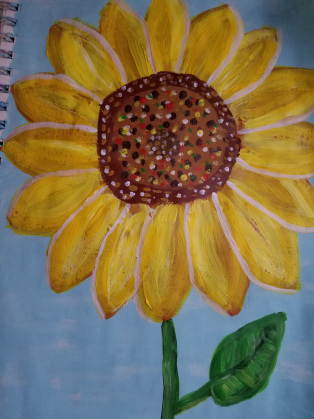
I watched an Angela Anderson tutorial on YouTube to paint this one.
I feel as if art journaling was invented for someone like me—someone who loves to play with paint and color but doesn’t have much background knowledge about how to actually make art. I’ve been having a lot of fun playing around in my art journal, and that’s all that matters. Some pages I like more than others. For some pages I use examples I’ve been on Pinterest or YouTube as my inspiration, and some pages come completely from my imagination. Some of my pages are kind of cool, and some are kind of weird, but you know what? It’s all good. Anything I do in my art journal is right for me. So there, all you Dobbies of the world!
While I will always be a writer first, I’m enjoying having other artistic pursuits. I can’t write all day, and coloring and art journaling give me something to do that is stressless, fun, and still creative.
Filed under: News, Spirituality, Tidbits Tagged: art journaling

July 26, 2016
My Summer Reading List
There’s always something special about summer reading. Of course I read during the school year, but with everything I have to do for my teaching and coursework there isn’t as much time to read for pleasure as I’d like.
Normally, I read a lot of fiction, mainly historical fiction (surprised, right?), but this summer I was bitten by the Hamilton An American Musical bug like so many of you. Not only have I listened to the soundtrack more times than I can count (I’m pretty sure at this point I could perform all the roles in the show), but more than loving the rhythmic music and the eloquent lyrics, listening to Hamilton reminds me of the days when I taught U.S. History. I remember glossing over Alexander Hamilton in the American Revolution lessons saying, “Oh yeah, that’s the guy who was shot and killed by Aaron Burr” and not thinking much more of him than that. Man, was I wrong about Hamilton. He was one interesting dude. My interest in Hamilton the musical reignited my interest in early American history, so most of my reading this summer has been biography driven.
Here’s my reading list this summer so far:
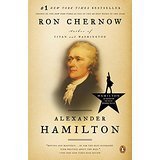 In keeping with my American Revolution theme, I’ve read the Alexander Hamilton biography by Ron Chernow as well as Chernow’s biography Washington: A Life. Here’s the interesting thing: George Washington, the first president, the father of his country, was not the most endearing person in the world, at least not to me. He was a great man, Washington, and the fact that we even have a United States is due in large part to Washington’s leadership. Still, Alexander Hamilton, even with his fiery temperament (or because of his fiery temperament) is the more interesting man. But I’m still glad I read the Washington biography. Chernow made me rethink
In keeping with my American Revolution theme, I’ve read the Alexander Hamilton biography by Ron Chernow as well as Chernow’s biography Washington: A Life. Here’s the interesting thing: George Washington, the first president, the father of his country, was not the most endearing person in the world, at least not to me. He was a great man, Washington, and the fact that we even have a United States is due in large part to Washington’s leadership. Still, Alexander Hamilton, even with his fiery temperament (or because of his fiery temperament) is the more interesting man. But I’m still glad I read the Washington biography. Chernow made me rethink 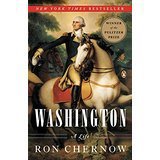 everything I thought I knew about George Washington, which is a good thing. Too often we just accept the stories we hear about our leaders without taking the time to read for ourselves and form our own judgments. Another biography I’ve read this summer is Walter Isaacson’s Benjamin Franklin: An American Life. I have to say I’m kind of digging on Benjamin Franklin right now. He wasn’t perfect—no one is—but I have to say he’s my favorite
everything I thought I knew about George Washington, which is a good thing. Too often we just accept the stories we hear about our leaders without taking the time to read for ourselves and form our own judgments. Another biography I’ve read this summer is Walter Isaacson’s Benjamin Franklin: An American Life. I have to say I’m kind of digging on Benjamin Franklin right now. He wasn’t perfect—no one is—but I have to say he’s my favorite 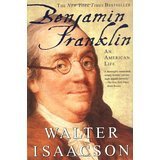 founding father. If all he ever did was make his discoveries about electricity, that alone would be enough for us to know his name. He was stubborn, determined, gregarious, but most of all he was damn funny, which scores points with me every time.
founding father. If all he ever did was make his discoveries about electricity, that alone would be enough for us to know his name. He was stubborn, determined, gregarious, but most of all he was damn funny, which scores points with me every time.
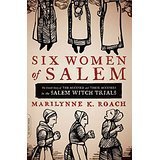 Since one of my jobs this summer has been to research the Salem Witch Trials for Down Salem Way, I’ve been reading The Salem Witch Trials: A Day by Day Chronicle of a Community Under Siege and Six Women of Salem, both by Marianne K. Roach.
Since one of my jobs this summer has been to research the Salem Witch Trials for Down Salem Way, I’ve been reading The Salem Witch Trials: A Day by Day Chronicle of a Community Under Siege and Six Women of Salem, both by Marianne K. Roach.
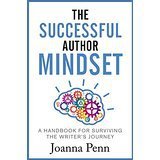 As I’m trying to move my writing career to the next level, I read the newest nonfiction book from one of my favorite publishing teachers, Joanna Penn (Joanna doesn’t know it, but she is one of my mentors!). Joanna’s book The Successful Author Mindset is great for authors at any stage of their careers. I’m five years into my author/publishing career, and though a lot of what Joanna says is common sense, it’s the kind of common sense you need to be reminded of when you’re feeling the stress to learning how to be an author in the 21st century.
As I’m trying to move my writing career to the next level, I read the newest nonfiction book from one of my favorite publishing teachers, Joanna Penn (Joanna doesn’t know it, but she is one of my mentors!). Joanna’s book The Successful Author Mindset is great for authors at any stage of their careers. I’m five years into my author/publishing career, and though a lot of what Joanna says is common sense, it’s the kind of common sense you need to be reminded of when you’re feeling the stress to learning how to be an author in the 21st century.
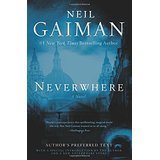 I haven’t been reading much fiction this summer, which is unusual for me, but the one novel I have read is Neverwhere by Neil Gaiman. I had read Gaiman’s The Ocean at the End of the Lane last year and really enjoyed the story’s magical realism, and I’m so glad I tried Neverwhere. You can call Neverwhere a Harry Potter for adults with the invisible underground stations and parallel lives in different dimensions, but that would be too simplistic to explain this quirky dark fairy tale. I already have Gaiman’s American Gods downloaded onto my Kindle.
I haven’t been reading much fiction this summer, which is unusual for me, but the one novel I have read is Neverwhere by Neil Gaiman. I had read Gaiman’s The Ocean at the End of the Lane last year and really enjoyed the story’s magical realism, and I’m so glad I tried Neverwhere. You can call Neverwhere a Harry Potter for adults with the invisible underground stations and parallel lives in different dimensions, but that would be too simplistic to explain this quirky dark fairy tale. I already have Gaiman’s American Gods downloaded onto my Kindle.
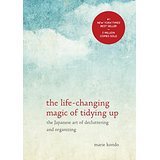 I’ve also read The Life-Changing Magic of Tidying Up by Marie Kondo. I never thought of myself as a hoarder (at least not by TV standards), but even so I could relate to the idea of keeping things only the things that bring you joy and donating the rest. I’ve downsized considerably since reading Kondo’s book, and it’s true—you really do feel lighter because of it. And also, because I’m about that age (I’ll be 47 next month), I’m currently reading Goddesses
I’ve also read The Life-Changing Magic of Tidying Up by Marie Kondo. I never thought of myself as a hoarder (at least not by TV standards), but even so I could relate to the idea of keeping things only the things that bring you joy and donating the rest. I’ve downsized considerably since reading Kondo’s book, and it’s true—you really do feel lighter because of it. And also, because I’m about that age (I’ll be 47 next month), I’m currently reading Goddesses 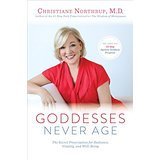 Never Age by Dr. Christiane Northrup. The book is a positive look at aging as it talks about staying active, being healthy, and not believing that your body has to break down just because you pass a certain birthday. The older I get, the more I appreciate that message.
Never Age by Dr. Christiane Northrup. The book is a positive look at aging as it talks about staying active, being healthy, and not believing that your body has to break down just because you pass a certain birthday. The older I get, the more I appreciate that message.
I still have a few more weeks of summer so I can fit in a few more books. What have you been reading this summer? I’m always up for recommendations!
Filed under: Book Reviews, Fiction, News, Nonfiction Tagged: book reviews, books, summer reading, summer reading list

July 18, 2016
Researching Historical Fiction—The Victorian Era
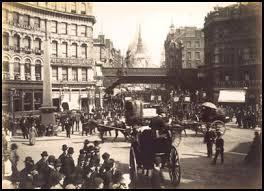
I have an odd habit of choosing to write historical fiction set in eras I know little to nothing about. I came up with story ideas about the Salem Witch Trials, the Trail of Tears, Biblical Jerusalem, New York City and Washington, D.C. during the woman’s suffrage movement, and the American Civil War, and for those stories I had to learn about the history to write the novel. I don’t mind when it happens that way, though. I’ve always been fascinated with history, and I enjoy learning about the past. I often get ideas for the plot from my research, so the research helps to make my novel even richer than it might have been without the historical background.
Writing When It Rained at Hembry Castle was different. I was already familiar with the era because of my love for Dickens. This time, it was more about reminding myself what I already knew (it had been 20 years since grad school by then) and figuring out how to use that knowledge in this story I had been kicking around for two decades. I realized early in the process that now I wanted to include aspects of my favorite TV show—Downton Abbey. The aspiring young writer Edward Ellis was still the focal point of the story, but now I wanted to include upstairs/downstairs elements as well.
To begin my research, I started with the author I know best—Dickens. Of course I’ve read all his novels, many more than once, so I started with the one I knew had the most in common with the story I had in mind for Hembry—Our Mutual Friend. From there, I went back to a few favorite books about the Victorian Era—What Jane Austen Ate and Charles Dickens Knew by Daniel Pool and The Victorian City: Everyday Life in Dickens’ London and Inside the Victorian Home: A Portrait of Domestic Life in Victorian England by Judith Flanders. I had read both of those books previously but reread them for a refresher course. While reading about the Victorian Era, I discovered a new favorite historian, Ruth Goodman, who impressed me with the fact that she doesn’t just talk about Victorian clothing, she makes it and wears it. She’s tried out many elements of living in the Victorian era, which gives her work that much more authority. Her book, How To Be a Victorian: A Dusk-to-Dawn Guide to Victorian Life, is a must read for anyone interested in life during the Victorian period. I also read The Writer’s Guide to Everyday Life in Regency and Victorian England From 1811-1901 by Kristine Hughes. Edward Ellis is loosely based on a young Charles Dickens, but I didn’t need to read anything specifically for that since I’ve read pretty much every biography about Dickens. It was nice to be able to use information I had in my head for a change.
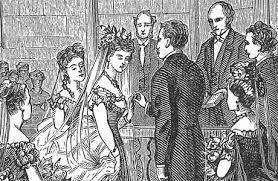
After my refresher course on Victorian England, I realized that I needed to learn more about what the upstairs/downstairs world looked like in the 1870s. To my surprise, it wasn’t so different from the way it’s portrayed in Downton Abbey, which begins in 1912 during the Edwardian era. While I picked up a lot about manor house living from watching Downton, as many fans of the show have, I felt I needed more specifics so I read Up and Down Stairs: The History of the Country House Servant by Jeremy Musson. I gleaned some great information from that book, and it provided good background for me so I could see how the country house servant evolved over the years. The upstairs/downstairs world isn’t part of our culture in America the way it is in England, and I wonder if that accounts for Americans’ fascination with Downton Abbey—it’s a glimpse into a lifestyle we weren’t familiar with.
The way I research historical fiction has changed a lot over the years. I used to do months of research before I ever started writing. Now I do a few weeks worth of preliminary research to get a feel for the era, and then I start writing. As I write, I get a sense of what information I need so I know exactly what to look for. As I was writing, I realized that if Edward was a political journalist then he would know politics. I needed to figure out the political climate of the time, but it wasn’t too hard since I knew what I was looking for—events in British politics in 1870. I remember learning about Gladstone and Disraeli in a class I took years ago, and it was nice being able to put that knowledge to use.
Through the writing process I also realized that I needed information about Victorian etiquette. There were such specific rules for every aspect of life, and since part of Daphne’s struggle is to learn to live in this upstairs/downstairs world, she had to learn those rules. I found The Essential Handbook of Victorian Etiquette by Thomas E. Hill, which was written for Americans during the Victorian era, but after a little digging I discovered that the rules were the same in Britain so I used that book as my primary reference. The etiquette seems so antiquated now. I had a lot of fun writing those scenes because Daphne is rather amused by her grandmother’s nitpicking about how her manners aren’t refined enough for English society.
I was lucky enough to be able to visit England twice prior to writing When It Rained at Hembry Castle. Most of the London locations in the story were chosen because they were places I’ve visited myself so I had seen what I was describing. I stood on the Victoria Embankment near the Houses of Parliament watching the Thames roll as Edward is wont to do. I’ve taken a couple of Edward’s walks through the city. Many of the buildings are different (I’m pretty sure the The Gherkin wasn’t around in 1870), yet some of the buildings are the same, which is amazing to me. Here in Las Vegas buildings are imploded if they’re more than 20 years old.
In many ways, researching When It Rained at Hembry Castle was the easiest work I’ve done so far for a historical novel since I was already familiar with the time. It’s always magical to me when I start to see how I can take this knowledge of history and weave it into the story I have in mind. What is even more amazing is when the history leads the story in directions I had never considered before. That, for me, is the joy of writing historical fiction.
Filed under: Charles Dickens, Historical Fiction, When It Rained at Hembry Castle, Writing Tagged: books about Victorian England, Charles Dickens, historical fiction, researching historical fiction, Victorian England, When It Rained at Hembry Castle, writing historical fiction

July 8, 2016
Love Paying 99 Cents for Books? My Annual Book Sale is On Now
I hope everyone is having a wonderful summer so far. I’ve been getting a lot of work done, but I’ve also been taking some time off. I’ve always felt fortunate that I have summers off to recharge my batteries, especially since things can get so hectic during the school year. I’ve been tapping into my creativity this summer since I’ve recently discovered art journaling, which I’ve been having a ridiculous amount of fun with. The thing with art journaling, like writing journaling, is that it’s not about creating a finished product—it’s about the discovery and the joy in the process. I’ve never taken an art class and I know nothing about how to create art, but that’s why art journaling is great. It’s a pressure-free chance to play and experiment with art supplies and colors. Here’s the page I finished yesterday:
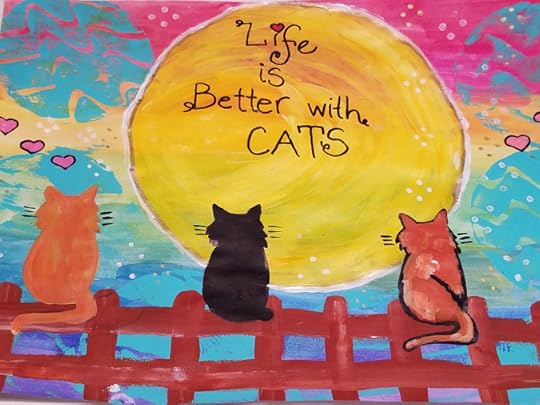
I don’t know if the page is completely done since I might like to add more details. In case you’re wondering, the three cats are my Chuck, Tillie, and Ellie. I’m not ready for faces yet, so rear end views will have to do for now!
Loving Husband Trilogy fans will be pleased to know that I’ve completed the first draft of Down Salem Way. The story is now in the baking stage where I let it percolate a bit while completing the research I’ll need to make the story come alive during the revision process.
I’ve teamed up with Penny Sansevieri and Author Marketing Experts to help get the word out about When It Rained at Hembry Castle. The reviewer at Kirkus Reviews had some very nice things to say about the book:
Allard (History Will Be Kind, 2015, etc.) is a seasoned author, and her experience shows in both the lapidary prose and the sensitivity with which she treats class division. Edward, for example, comes from humble origins, but he’s shown to be actually more comfortable with upper-class stodginess than Daphne is, as he grew up in the castle. Daphne’s father, meanwhile, is marvelously progressive, but it’s intriguingly unclear if he’s completely liberated himself from his affluent station. Overall, this is a delightful, often funny story that also serves as a gimlet-eyed study of class division and the possibility of its transcendence. An unpretentiously philosophical assessment of class and love.
Author Marketing Experts have put together a few book promotions for When It Rained at Hembry Castle so the novel is now on sale for 99 cents. While I was changing the price for Hembry, I realized it was time for my annual summer sale where all my books are 99 cents. Her Dear & Loving Husband, Book One of the Loving Husband Trilogy, is still free.
Here are the books that are on sale for 99 cents:
When It Rained at Hembry Castle
Perfect for fans of Downton Abbey, When It Rained at Hembry Castle is the story of an aristocratic family, a mysterious death, secrets that dare not be told, and the wonder of falling in love.
When the 8th Earl of Staton dies, his eldest son, the unreliable Richard, inherits the title and the family’s home—Hembry Castle. Soon after, Frederick Meriwether, the new earl’s brother, arrives back in England from America, bringing his beautiful daughter, Daphne, with him.
Though Frederick’s mother has grand plans for Daphne—which may include a duke—Daphne is intrigued by Edward Ellis, a rising author with a first-hand knowledge of Hembry Castle—from the servants’ hall. And Edward, though captivated by the lovely Daphne, has his own hurdles to overcome.
Can Richard come to terms with his new role before bringing ruin on his family? Will Edward and Daphne find their way to each other despite the obstacles of life at Hembry?
Amazon
BN
iTunes
Kobo
Her Loving Husband’s Curse (Book Two of the Loving Husband Trilogy)
And then, as if he could read her mind, he said, “We’ll be all right, Sarah. Just the two of us. I’ll never leave you ever.”
Finally, after many long and lonely years, James Wentworth’s life is falling into place. With his wife, Sarah, the only woman he has ever loved, he has found the meaning behind her nightmares about the Salem Witch Trials, and now they are rebuilding the life they began together so long ago.But the past is never far away for the Wentworths. While Sarah is haunted by new visions, now about the baby she carried over three hundred years before, James is confronted with painful memories about his time with the Cherokee on the Trail of Tears. Through it all, the persistent reporter Kenneth Hempel reappears, still determined to prove that the undead walk the earth. If Hempel succeeds in his quest, James and Sarah will suffer. Will the curse of the vampire prevent James and Sarah from living their happily ever after?
Amazon
BN
iTunes
Kobo
Victory Garden
Mr. President, what will you do for woman suffrage?
It’s 1917, and Rose Scofield knows exactly what she’ll do for woman suffrage. She’ll fight with her very life to make votes for women a reality.
A headstrong young woman who yearns to be herself in a time when women weren’t free, Rose comes of age when world wars are new and automobiles, moving pictures, and airplanes are marvels of technology. She falls in love with Adam Bell, a vaudeville actor who travels the country with his brothers gathering laughs and hard knocks, though she denies her feelings for him, fearing he could prove to be her weakness.
Can we trust our government to do what is best for us? What must we sacrifice in times of war? And what must women suffer to be truly equal? Victory Garden is a reminder of how far we’ve come…and how far we still have to go.
Amazon
BN
iTunes
Kobo
Woman of Stones
If any one of you is without sin, let him cast the first stone. John 8:7
Though she has remained nameless throughout the centuries, her story is timeless. Who is the woman of stones? How did she come to be at that place, at that time, caught in the very act of adultery, left as a guidepost for the ages, a lesson for everyone always?
She is from a poor settlement in a powerful Greco-Roman world. When Othniel bar-Ismael, a textile merchant from Jerusalem, arrives in her village, he is determined to take her for his wife. But the reality of living as a fine lady is not as grand as she thought it would be. When she meets the man of her dreams, an acquaintance of her husband’s, her life is forever changed.
Caught with her lover, she is beaten and bruised, dragged and kicked to the Temple Courts. Her accusers hold their fist-sized stones, ready to challenge this new teacher and show him to be a fool who contradicts his own teachings. With a few wise words, the teacher makes her accusers go away. In the end, she must struggle to make sense of the second chance she has been granted.
Amazon
BN
iTunes
Kobo
That You Are Here
On the outside, handsome, successful attorney Andrew Whittaker has everything in life. On the inside, he has everything too, only he doesn’t know it. Andrew hides the love of his life, Mark Bryce, from his family and everyone else where he lives in Portland, Oregon. Soon the weight of the secret becomes too much for Andrew. After wrestling with himself and his place in the world, Andrew must decide how he’s going to live—with or without Mark.
Amazon
BN
iTunes
Kobo
The books are on sale until August 15. Happy reading!
Filed under: Down Salem Way, Her Loving Husband's Curse, News, That You Are Here, Victory Garden, When It Rained at Hembry Castle, Woman of Stones Tagged: 99 cent books, 99 cent promotions, summer book sale

June 21, 2016
Productivity for Writers and Other People
It’s interesting to me to see how conversations change over time. Not so long ago everyone was praising multi-tasking as the best thing ever. Hey, I can write the world’s greatest novel while reading blogs while checking every new email the moment it pops into my inbox while keeping track of every ping on Facebook and Twitter while walking the dog while doing my taxes while binge watching Netflix while juggling watermelons while yodeling to the tune of “O Solo Mio.” At the end of the day I’d wonder why I hadn’t written more. Had I really lost an entire day watching cat videos on YouTube? Then I realized that I didn’t want to spend more time working. I wanted to get more done.
Around this time, I started seeing articles about how multi-tasking may not be all it was cracked up to be. We weren’t putting all our attention and talent into any one task; as a result, we weren’t working to the best of our abilities because our attention was too scattered. Enter the discussion about productivity.
I think the reason there are so many articles about productivity is because so many of us are struggling with the same issue—how do we work more efficiently so that we’re getting more and better work done in less time? Here are a few tricks I’ve learned lately that have helped me stay focused while I’m working. I wrote this post from the point of view of a writer hoping to steal back some of her precious time to get more writing done, but I hope anyone who is having some concerns about their productivity will find these tips useful.
I changed my homepage for the Internet.
Since I’ve had the Internet in the mid 1990s I’ve used AOL as my homepage. My email address is through AOL, so by using AOL as my homepage I could check my email as soon as I logged online. But you know how it goes…there are the news links, the entertainment links, the books links, along with any other links that might catch my eye. Once AOL and The Huffington Post joined hands, I was done for. I’d spend an hour reading blog posts and getting no work done in the process. Was it fun? For sure, though there were definitely times when I was wondering why I was reading about celebrities I didn’t even care about. I had just wasted an hour I could have spent getting my work done.
About three months ago I changed my Internet homepage to my own website. That might sound a little self-serving, but it helps me in two ways. First, I can do a quick glance at my site to see if there are comments I need to respond to, which I can often do in under five minutes. Second, there are no news feeds to distract me so I’m able to get right to whatever it is I need on the Internet. Yes, I have to click on one or two more links to get to my email, but it’s worth it to me to skip over the distractions.
I check my email twice a day.
I check my email in the morning to see if there’s anything imperative that needs seeing to, and then I check my email at the end of my work day to see if there’s something that came in since the morning. That’s it.
I removed the Facebook and Twitter apps from my phone and iPad.
Now the only way I can access Facebook and Twitter is to log in on my computer. This extra step helps to scratch the itch that used to lead me to check my social media pages every five minutes to see if someone posted a new cute cat photo. I check Facebook and Twitter twice a day, quick scans to see what others are up to and if there’s anything I need to respond to, which, again, I can usually do in less than five minutes.
I schedule my Facebook, Twitter, and LinkedIn posts.
I use Hootsuite to schedule my posts on Facebook, Twitter, and LinkedIn. It takes about an hour to schedule a week’s worth of posts, and then I’m done and don’t have to worry about what to post on social media.
I started using Google calendar to schedule my daily tasks.
For years I used paper and pencil notebooks and planners, but in my new wish to downsize my belongings (I love Marie Kondo’s books about decluttering) I’ve become totally electronic. Google calendar is heaven sent. It’s free, and all you need is a gmail account, which is also free. You can share your calendar with others, or you can keep it private. So now I know each day what I need to accomplish.
For example, today I had several tasks to tend to: complete my word count for the first draft of Down Salem Way, write this blog post, and find five sites to advertise Her Dear & Loving Husband, which is once again free. When those tasks are finished, I’m done with my work for the day, which is always a good feeling. Knowing what I have to do helps me stay focused. When I wasn’t keeping track of my daily tasks I just floated about looking at stupid stuff on the Internet because I was never sure what to do next so I’d go back to those cute cat videos on YouTube.
On a side note, I also find that it helps to know exactly what I’m looking for when I go onto the Internet. Right now, I’m back to researching the Salem Witch Trials for Down Salem Way, and I’m also looking for places to advertise When It Rained at Hembry Castle and Her Dear & Loving Husband. I have those tasks on my Google calendar too so I know what I’m searching for. It stops me from going back to (you guessed it–the cute cat videos).
I turned off the TV.
Not completely turned it off because I do love my Netflix and Amazon Prime streaming. For years, even if I wasn’t watching a show I had the TV on acting as background noise. Now the TV is off, as in off off, with a blank screen and everything. I started listening to music because music always helps to get my creative juice flowing. I’ve also started listening to podcasts because I realized I’d rather listen to some intelligent conversation than some TV show I don’t care about, and I can listen while I work. Rather than distracting me, the podcasts tap into my inquisitiveness about the world and they help me think, which is always a good thing.
My podcast tastes are pretty eclectic, like everything else about me. I love podcasts about writing and the publishing industry like Joanna Penn’s The Creative Penn. As I’m learning more about productivity, I’m also learning more about how to be centered and healthy in this crazy world of ours so I listen to Shawn Stevenson’s The Model Health Show and Pedram Shojai’s The Urban Monk. The School of Greatness with Lewis Howes is also pretty cool, and Shambhala features talks by famous meditation teachers in their podcast Meditation in the City. There are so many podcasts out there. Just search and you’ll find something right up your alley.
I had to learn to stop checking everything everywhere.
We’ve all heard of the social ill the Fear of Missing Out (affectionately—or not depending on your point of view—known as FOMO). I was right there with everyone else, checking my social media every five minutes, worrying that what was going on over there was more important than what was going on over here. Also, because I’m a writer I was constantly checking my stats on my website and my book sales. Why did I sell more books on Wednesday than Monday? How come this book’s sales have slipped? Why did this post get more views than that post? I’d check my Amazon sales page five or six times a day, as if things were going to be that different between 3 and 5 pm. And then when things were the same I felt disappointed that some magical sales boost hadn’t happened.
Not only is this kind of constant worry exhausting, it isn’t productive. When I was worried about book sales or website stats I should have been writing. There was some time there when I was a writer who wasn’t writing—or at least I wasn’t writing as much as I could have been. I was so concerned about all these other aspects, some of which were beyond my control, and you know what? They don’t matter. Sales don’t matter. Website hits don’t matter. The only thing that matters is how I feel about what I’m doing. I was allowing other people’s perceptions of me (or even worse, my own perception of other people’s perceptions of me) to affect how I felt about myself, and that, my friends, is never a good thing.
As a result, I put myself on my “no checking stats” rule that I live by to this day. I no longer check my Amazon, BN, or Kobo sales pages. I no longer check to see how many page views my latest blog post has. My one exception is that when I’m running a promotion I may check my book sales pages to see if the promotion is worth its weight in beans, but otherwise my Amazon page is a no-go. Because you know what? My books are going to sell as many copies that day as they’re going to sell whether I’m compulsively checking or not. Why make myself crazy and waste time in the process? Yes, it does takes some self-restraint to go from checking 10 times a day to zero times a day, but it is possible. If you’re not able to go cold turkey like I did, maybe try checking just once a day and see how that goes.
I started paying more attention to my health.
There was a time in the not-so-distant past when I wasn’t eating well. I was eating and drinking way too much sugar, and my exercise habits had all but disappeared. As I’m working toward becoming a more productive writer, I’m also learning more about health and wellness (mostly from the afore mentioned Model Health Show podcast from Shawn Stevenson). I’ll have more to say about this in a later post, but for now I’ll say that whoever you are, no matter what your profession, you have to get up and move. You have to put healthy food into your body. You have to drink more water. The better you feel, the more productive you’re able to be because you’re healthier. It’s hard to be productive when you feel lousy. Do what you can to help yourself feel better.
I am definitely getting more work done in less time. I’m no longer wasting time—or, more accurately, I’m wasting far less time. I still spend more time on Pinterest than I need to, but hey, no one’s perfect. For the first time, I’m writing two books at a time, which is something I’ve never been able to do before. By whittling away at time wasters and finding ways to streamline my work time, I’ve been able to get more done. From now on, instead of multi-tasking, I’ll be focusing on productivity.
Filed under: Publishing, Writing Tagged: productivity, productivity for writers, writing, writing tips

June 7, 2016
Visiting Old Friends: Writing Down Salem Way
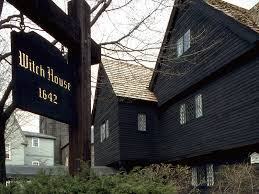
Witch House in Salem, MA, which looks remarkably like James’ house.
As I said in this post, it’s hard to believe it’s been five years since Her Dear & Loving Husband was published. For those of you who have been following me, you know that I’m finally working on the new Loving Husband tale, Down Salem Way.
I know conventional wisdom says to write as many books in a series as you can, but I’ve found that, for me at least, it’s best to write whatever it is that’s in my heart to write. Perhaps that’s not the best business model, but it works for me. When I finished writing the final book in the Loving Husband Trilogy, Her Loving Husband’s Return, I felt that James and Sarah’s story was complete. I already knew the next two novels I was going to write—That You Are Here and When It Rained at Hembry Castle. As a result, I had my writing planned out for the next two years since I write about one novel a year.
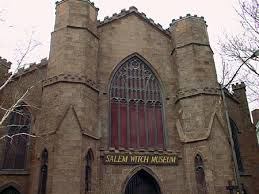
The Witch Dungeon Museum in Salem, MA.
Then a funny thing happened. I kept getting emails from Loving Husband fans who asked for the story to continue. For a while I said no, the story was pretty well wrapped up at the end of HLHR, but then I began to wonder myself if there was more to James and Sarah’s story. When I wrote Her Dear & Loving Husband, I was fascinated by what I learned about the Salem Witch Trials. Though the novel goes into that sad time in depth, I felt there was more to know about Salem in 1692 than I was able to touch on in the context of that one book. Perhaps a continuation of James and Sarah’s story could allow me to focus once again on the witch hunts.
I’ve been writing historical fiction since 1994, and it has been a dream come true to write a story of everlasting love that resonates with readers around the globe. I was thrilled that readers loved James and Sarah so much they wanted more. If I were a good business-minded author, which I’m not, I would have written Down Salem Way as soon as I had the idea so I could get it out right away and capitalize on the success of the Loving Husband Trilogy. But I already had my mind—and most importantly my heart—set on writing That You Are Here and When It Rained at Hembry Castle. I took the less traditional route and decided to carry through with the two novels, and then, after they were written and published, I would work on Down Salem Way.

The Friendship, which is docked near Pickering Wharf, where Olivia’s shop The Witches Lair is located.
There were a couple of challenges along the way. First, I’m back in college full time both taking and teaching classes. I’m glad I made the decision to return to school because I needed a new challenge, but it does take time away from writing fiction. The second challenge was the fact that When It Rained at Hembry Castle was more difficult to write than I expected so it took me two years to write instead of one. With That You Are Here and When It Rained at Hembry Castle both out in the world, I was finally able to turn my attention to Down Salem Way.
I’m about halfway through my “shitty first draft” phase, and even though most of what I’m writing in that first draft will never see the light of day since it will be completely revised by the time the book is published, it’s still a joy watching the story start to take shape. At first, I saw Down Salem Way as a prequel to the Loving Husband Trilogy, and in a way it still is. I thought the story would only take place in Salem during the time of the witch trials, but then I realized I needed to keep the past and present storylines readers have come to love. As a result, Down Salem Way has become both a prequel—an insight into James and Elizabeth’s lives prior to the madness of the witch trials—and a sequel as we follow James and Sarah in their new lives in California. The whole gang will be there–Olivia, Jennifer, Chandresh, Timothy, and Howard. And what would a Loving Husband story be without Geoffrey?
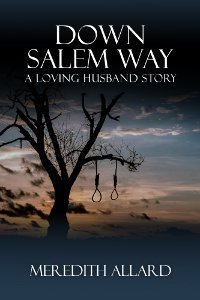 Although it’s been a long wait for James and Sarah fans, it’s been a good thing for me that there has been some time since I finished writing Her Loving Husband’s Return and started Down Salem Way. Now I’m as excited as Loving Husband Trilogy fans to see what’s next for James and Sarah. For those of you who have been patiently awaiting the new Loving Husband story, you’ll be happy to know that the book is right on track for an October release—just in time for Halloween.
Although it’s been a long wait for James and Sarah fans, it’s been a good thing for me that there has been some time since I finished writing Her Loving Husband’s Return and started Down Salem Way. Now I’m as excited as Loving Husband Trilogy fans to see what’s next for James and Sarah. For those of you who have been patiently awaiting the new Loving Husband story, you’ll be happy to know that the book is right on track for an October release—just in time for Halloween.
If you’d like to read my posts about my research trip to Salem, MA, click here. A number of you have already signed up for updates about Down Salem Way. If you’d like to join the mailing list, click here.
Filed under: Down Salem Way, Her Dear & Loving Husband, Her Loving Husband's Curse, Her Loving Husband's Return, Historical Fiction, Writing Tagged: Down Salem Way, Her Dear and Loving Husband, Her Loving Husband's Return, historical fiction, The Loving Husband Trilogy, writing historical fiction

May 16, 2016
99 Cent Promotions: Which Had the Best Results?
When I first released When It Rained at Hembry Castle in February, I decided to set the price at 99 cents so I could use the first couple of months to run ads on the various book promotions sites. While you can advertise your book with prices higher than 99 cents, general wisdom says the lower your book is priced the better it will sell. I tend to believe that’s true because readers who sign up for these lists are looking for bargains.
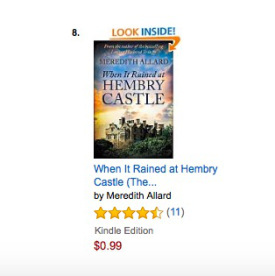
When It Rained at Hembry Castle was in the Top 20 of its genre categories for most of the three months I used the book promotions.
I had used book promotion sites in the past, but I wanted to be as systematic as I could this time. I knew I needed a new audience for When It Rained at Hembry Castle than I had for any of my other books. While there are some readers of my Loving Husband Trilogy who read and loved Hembry, I still had to help new readers discover the novel. Phase One of my marketing plans was to try as many book promotion sites as I could.
I decided to write this post because when I was searching for sites where I could promote my 99 cent books I found articles like this extremely helpful and I wanted to do the same for others. I’m not advocating certain book promotions—I’m simply sharing my own experiences.
I admit I have a different outlook on book promotions than others. I’ve read comments from some writers who said they don’t pay for promotions because often the promotion costs more than they’ll make from sales. I’ve found that to be true since if I’m promoting a book that’s 99 cents then I’m making about 30 cents per copy sold. This is where you need to consider your goals.
If you’re only interested in making a profit, then 99 cent promotions probably aren’t for you. If you’re looking for exposure, getting your book in front of eyeballs, and making sales in the process, then I highly recommend 99 cent promotions. I broke about even between the amount I spent on the promotions and the amount I made, and for me it was worth it. The promotions didn’t make me rich, but they did get my book seen and, most importantly, bought.
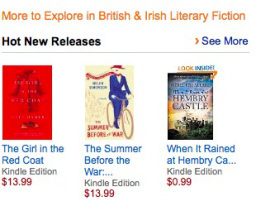
Hembry was named a Hot New Release by Amazon shortly after it was published.
I’ve heard that readers need to be exposed to a book at least seven times before they buy it (some say it takes 20 times for someone to buy what you’re selling, but seven sounds better so let’s say seven). For myself, I rarely buy a book the first time I hear about it. If I hadn’t heard about the book more than once I probably wouldn’t have given it another thought. If doing the promotions helps to give potential readers their first, second, or even fifth viewing of my book, then to me it’s money well spent.
The Numbers
2/7/16
Free Kindle Books and Tips—36 sales
2/9/16
Books Butterfly—19 sales
2/10
Books Butterly—32 sales
2/11
Awesome Gang—26 sales
2/12
Genre Plus—8 sales
2/15
OHFB—78 sales
2/17
Betty Book Freak—26 sales total for the day
(This was a mistake on my part—I set two promotions on the same day. I don’t recommend doing this because then it’s harder to tell where the sales are coming from.)
2/19
Many Books—60 sales
2/23
Fussy Librarian—46 sales
2/26
New in Books—on list “6 Books to Read if you Love Downton Abbey”—34 sales
2/29
eBook Hunter—21 sales
3/8
Book Gorilla—122 sales
3/23
The eReader Cafe—88 sales
3/26-3/27
Books Butterfly—68 sales
4/5
Book Sends—83 sales
4/7
eBooks Habit—10 sales
4/11
Kindle Book Review—9 sales
4/13
The Fussy Librarian—40 sales
4/16
Kindle Book Review—6 sales
4/20
Read Cheaply—23 sales
4/21
Read Cheaply—35 sales
4/23
EReader News Today—215 sales
4/25
BK Nights—26 sales
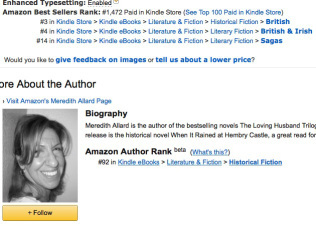
I had my first Amazon Author Rank after the EReader News Today promotion. The novel was #1,472 overall and #3 on the Historical Fiction British chart and #4 on the Literary Fiction British and Irish chart.
Even on days when I didn’t have a promotion running the novel still sold well—perhaps not as well, but still pretty well. I should also mention that there were times when I had Facebook ads running during these three months (working toward getting potential readers to that 7th—or 20th—time a charm visibility). No matter what marketing strategies you’re using, it’s impossible to say precisely where book sales are coming from—book promotions, Facebook ads, virutal book tours, Amazon algorithms, word of mouth, your Aunt Sally buying 50 copies—but I believe the promotions were the main catalyst because sales spiked on days when the book was being promoted.
Of course, once the promotions stopped and the price went to $2.99 sales slowed. It’s funny how your perspective changes. Normally, I’d be thrilled to see one of my books selling 4-5 copies a day, which is what Hembry is doing now, but after all those sales the 4-5 copies looked a little wimpy. That’s when I put myself back on my “no checking stats” rule which I normally live under (as I speak about here). I think it’s okay to check stats when you have a promotion going (which I did for three months), but then you need to remember there are other things that need your attention—such as writing new books, for example.
For my next experiment I’m going to try promoting Hembry at $2.99 and see what happens. Not all book promotion sites allow for $2.99 price points, but some do. Some charge more for the $2.99 promotions than they do for 99 cent promotions. But now I’m interested in comparing and contrasting what happened at 99 cents and what will happen at $2.99.
I’d love to hear what experiences others have had with book promotion sites.
Filed under: Publishing, When It Rained at Hembry Castle Tagged: 99 cent promotions, book marketing, indie publishing, publishing

May 9, 2016
An Interview with Emma Rose Millar
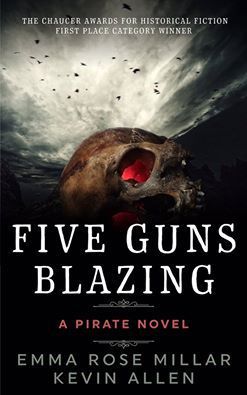 Emma Rose Millar is the co-author of the historical novel Five Guns Blazing, the first place winner of The Chaucer Award in Historical Fiction. Five Guns Blazing is an epic tale of piracy, slavery, and treason.
Emma Rose Millar is the co-author of the historical novel Five Guns Blazing, the first place winner of The Chaucer Award in Historical Fiction. Five Guns Blazing is an epic tale of piracy, slavery, and treason.
Meredith Allard: When and why did you begin writing, and did you always write historical fiction?
Emma Rose Millar: I’ve been writing stories for as long as I can remember. As a child I was painfully shy; back then writing was a means of expressing my feelings, a way to take myself off to an imaginary world. As I grew older though, other things seemed to take over and I found myself writing less and less. When I was in my thirties, I became mixed up in a very bad relationship and it was then that I began writing my first novel. Strains from an Aeolian Harp was a dark tale of opium addiction and domestic violence, set in 1920s England when women weren’t allowed to get divorced on the grounds of cruelty alone. I wrote that novel in secret; I was terrified of my partner finding out, but it was something I felt I needed to do. Thankfully my life is a much happier place now and I think that shows in my writing.
M.A.: What is your latest novel? How would you describe it to potential readers?
E.R.M.: My latest novel, Five Guns Blazing, is an historical adventure based on the true story of pirates Anne Bonny, Mary Read and John ‘Calico Jack’ Rackham:
1710: Convict’s daughter, Laetitia Beedham, is set on an epic journey from the backstreets of London, through transportation and grueling plantation life, into the clutches of notorious pirates, John Rackham, Mary Read and the treacherous Anne Bonny. In a world of villainy and deceit, where black men are kept in chains and a woman will sell her daughter for a few gold coins, Laetitia can find no one in whom to place her trust. As the King’s men close in on the pirates and the noose begins to tighten around their necks, who will win her loyalty and her heart?
M.A.: What makes your novels different from others about similar eras?
E.R.M.: Five Guns Blazing is a multi-layered story, not only one of piracy but also a tale of slavery in its various guises. Whilst writing the novel, it quickly became clear to me that I would need the help of a co-writer. I approached Jamaican-born author Kevin Allen and asked him if he’d read my half-finished manuscript. Fortunately for me, he liked the story so much that he agreed to work on it with me. Kevin wrote all the plantation scenes and changed some of the dialect. That was the beginning of our two year transatlantic writing affair. It was a long hard road but together I think we created something I could never have managed alone. The novel recently won first prize in its category in The Chaucer Awards for Historical Fiction. It was an incredibly proud moment for both of us.
M.A.: All authors have a different path as they seek publication. What was your journey to publication like?
E.R.M.: It was such a rollercoaster ride. I wholly believed in the novel and I put it through a professional edit before submitting it anywhere. Quite a few big agents in London asked to see the full manuscript after reading a sample. They all said that they loved the story but didn’t know what the market was for a book like this. It seemed it was always going to be a case of ‘close but no cigar’. For a while I’d been hearing good things about Crooked Cat Publishing in Edinburgh but they were closed to submissions at the time. As soon as they opened their doors again though I sent them Five Guns Blazing and I was thrilled when they accepted it. All of their authors were so welcoming. We work as a team; I’ve made so many lovely new friends.
M.A.: What are the joys/challenges of writing historical fiction for you?
E.R.M.:I love history, especially 18th and 19th century and I couldn’t imagine writing in any other genre. Writing historical fiction takes a tremendous amount research, but I love uncovering all those nuggets of history, stories and characters which I know will make a fantastic novel. While writing Five Guns Blazing I also discovered some fabulous old words: ‘bastardly gullion,’ ‘jerrycummumble,’ and ‘flaybottomist,’to name but a few.
M.A.: What is the research process like for you?
E.R.M.:I absolutely loved doing all the research into eighteenth-century piracy. In Anne Bonny I found the archetypal anti-heroine: treacherous, double-crossing and fiercely independent. Then there was John Rackham, a rake, devilishly handsome, the Casanova of the seas. Some sources suggest Rackham was captain in name only and it was Anne who ran the ship, terrorising all who sailed close to her. Their pirate adventure came to an abrupt end in 1720 when their ship, Revenge was captured and the entire crew sentence to death. But that wasn’t quite the end of the story. There is no record of Anne’s execution or of her release or escape from jail. What became of her is still a mystery. The more I read about the villainous pair, the more intrigued I became.
M.A.: Do you travel for research? If so, what role does travel play in your writing process?
E.R.M.: I’d have loved to go to the Caribbean as part of my research for Five Guns Blazing, but I’m a single mum and my son was far too little at the time to take a trip like that. Kevin regularly visits the islands though and he has a wealth of knowledge about their history. A lot of my own research came from the Galleries of Justice in Nottingham. They have an old court room there where they do reenactments of famous cases, an eighteenth century jail, complete with cells, exercise yard and gallows, and a fantastic transportation museum. My visits there were invaluable.
My next novel is set in Vienna and is based on a painting by Gustav Klimt. I’m hoping to go there for a few days in October with my son. He’s six now so I’m sure he’ll enjoy the zoo and the aquarium. Hopefully I’ll find some time to soak up the atmosphere and to see some of Klimt’s work while we’re there.
M.A.: Which authors are your inspiration—in your writing life and/or your personal life?
E.R.M.: I really admire Sarah Waters, Alice Walker, Philippa Gregory and Joanne Harris. Their writing is sublime. I did an Open University degree in English Literature about fifteen years ago though and my bookshelves are still heaving with novels by the Bronte sisters, Wilkie Collins, Charles Dickens, etc. I do love a good classic!
M.A.: What advice do you have for those who want to write historical fiction?
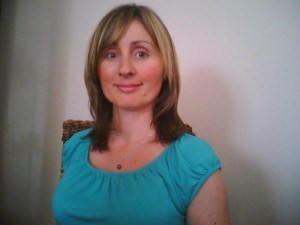 E.R.M.: I think good historical fiction starts with meticulous research and a great story. As with any genre, it takes a massive amount of work for an idea to blossom into published novel. The best thing I did was to find a good editor. He took the manuscript to another level; without him, it may never have been picked up by a publisher. Most of all, don’t give up; nothing worth doing ever comes easily. It’s an amazing feeling once you’ve completed a novel.
E.R.M.: I think good historical fiction starts with meticulous research and a great story. As with any genre, it takes a massive amount of work for an idea to blossom into published novel. The best thing I did was to find a good editor. He took the manuscript to another level; without him, it may never have been picked up by a publisher. Most of all, don’t give up; nothing worth doing ever comes easily. It’s an amazing feeling once you’ve completed a novel.
M.A.: What else would you like readers to know?
E.R.M.: Five Guns Blazing is now available on Amazon, Smashwords, and Barnes and Noble
Filed under: Guest Authors, Historical Fiction Tagged: Emma Rose Millar, Five Guns Blazing, guest authors, historical fiction, interviews, The Chaucer Award

April 28, 2016
Happy Anniversary, James and Sarah: Her Dear and Loving Husband is Five Years Old
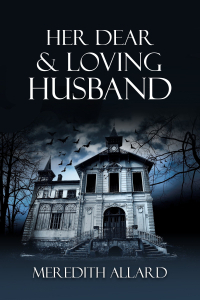
I can hardly believe this as I write it, but last week marked the fifth anniversary of the publication of Her Dear & Loving Husband. As of this writing, more than 200,000 copies of Her Dear & Loving Husband have been bought or downloaded (mostly downloaded since the novel has been perma-free most of its life). Thanks to some Very Nice People at wattpad.com, Her Dear & Loving Husband was recently added to their Featured List in Vampire Fiction. Prior to being added to the Featured List, HDLH had about 5,000 reads, which by itself is not too shabby. In the past three weeks, 21,5000 new readers have found James and Sarah’s story of eternal love, making a total of 26,500 readers on Wattpad, and that number is growing every day. It makes my heart glad to know that James and Sarah are finding new fans even after five years.
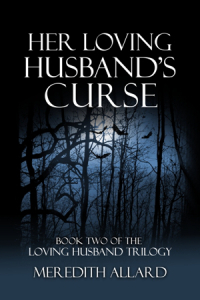 I’m now working (cross my heart) on Down Salem Way, the prequel to the Loving Husband Trilogy, and I’ve just finished revisiting HDHL as a way to refresh myself with the story. I hadn’t read Her Dear & Loving Husband in three years, and I thought it might be a good idea to reread the trilogy before I wrote the prequel. As funny as this might sound, I had forgotten how much I love James and Sarah. After I finished writing Her Loving Husband’s Return in 2013, and after putting together and marketing the trilogy’s complete box set in 2014, I was burned out and I didn’t want to churn out another Loving Husband story if it wasn’t in my heart to do so. I didn’t want to write about these characters I had come to love so much for the sake of getting something out. By 2014, I had been working on the James and Sarah stories for five years, beginning in 2009, when I first came up with this oddball idea of a vampire mourning his long-lost human wife. The two year break from the Wentworths was just what the doctor ordered. In that time I wrote two novels and now I’m raring to get back to James and Sarah and revisiting their time during the Salem Witch Trials.
I’m now working (cross my heart) on Down Salem Way, the prequel to the Loving Husband Trilogy, and I’ve just finished revisiting HDHL as a way to refresh myself with the story. I hadn’t read Her Dear & Loving Husband in three years, and I thought it might be a good idea to reread the trilogy before I wrote the prequel. As funny as this might sound, I had forgotten how much I love James and Sarah. After I finished writing Her Loving Husband’s Return in 2013, and after putting together and marketing the trilogy’s complete box set in 2014, I was burned out and I didn’t want to churn out another Loving Husband story if it wasn’t in my heart to do so. I didn’t want to write about these characters I had come to love so much for the sake of getting something out. By 2014, I had been working on the James and Sarah stories for five years, beginning in 2009, when I first came up with this oddball idea of a vampire mourning his long-lost human wife. The two year break from the Wentworths was just what the doctor ordered. In that time I wrote two novels and now I’m raring to get back to James and Sarah and revisiting their time during the Salem Witch Trials.
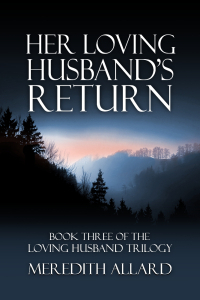 While I reread Her Dear & Loving Husband, I made a few editing changes, but not as many as I would have expected. I wouldn’t say my writing has changed drastically in the past five years, but there are a few things I’ve improved along the way. I’ve never been a fan of dialogue tags, and I’ve always tried to use them as little as possible. I think it’s more effective to set up the conversations so the reader can follow without having to point out who’s talking. I’m planning a series of posts about writing dialogue for May, but for now I’ll say the fewer dialogue tags the better. Even though I didn’t use a lot of dialogue tags in the earlier version of HDLH, I used them more than I do now so I deleted a number of he saids and she saids. I tightened up a few sentences because I’ve become better at adhering to my “no extra words” rule. I think even James and Sarah superfans will have a hard time spotting the changes, but I felt like, well, I’m rereading the book anyway, I might as well make whatever edits I think are necessary.
While I reread Her Dear & Loving Husband, I made a few editing changes, but not as many as I would have expected. I wouldn’t say my writing has changed drastically in the past five years, but there are a few things I’ve improved along the way. I’ve never been a fan of dialogue tags, and I’ve always tried to use them as little as possible. I think it’s more effective to set up the conversations so the reader can follow without having to point out who’s talking. I’m planning a series of posts about writing dialogue for May, but for now I’ll say the fewer dialogue tags the better. Even though I didn’t use a lot of dialogue tags in the earlier version of HDLH, I used them more than I do now so I deleted a number of he saids and she saids. I tightened up a few sentences because I’ve become better at adhering to my “no extra words” rule. I think even James and Sarah superfans will have a hard time spotting the changes, but I felt like, well, I’m rereading the book anyway, I might as well make whatever edits I think are necessary.
 I’ve decided to celebrate the Loving Husband Trilogy this summer in preparation for the autumn release of Down Salem Way. I’ve sent the revised version of Her Dear & Loving Husband out into the world, and I ordered new book descriptions for all three books in the series from Bryan Cohen from the Sell More Books Show, a podcast he does every week with Jim Kukral from Author Marketing Club. Bryan and Jim’s podcast is a must-listen for indie authors. If you’re not familiar with Bryan, he’s the Book Description King (my words), and as I’m learning more about book marketing I’ve discovered (yes, I learned this from Bryan) that book descriptions are there to encourage readers to buy your books, not just to rehash the story, which is what most book descriptions do—including mine! I can’t wait to see what Bryan does for the descriptions for the Loving Husband Trilogy. If you’re interested in spicing up your own book descriptions, you can visit Bryan online at Best Page Forward.
I’ve decided to celebrate the Loving Husband Trilogy this summer in preparation for the autumn release of Down Salem Way. I’ve sent the revised version of Her Dear & Loving Husband out into the world, and I ordered new book descriptions for all three books in the series from Bryan Cohen from the Sell More Books Show, a podcast he does every week with Jim Kukral from Author Marketing Club. Bryan and Jim’s podcast is a must-listen for indie authors. If you’re not familiar with Bryan, he’s the Book Description King (my words), and as I’m learning more about book marketing I’ve discovered (yes, I learned this from Bryan) that book descriptions are there to encourage readers to buy your books, not just to rehash the story, which is what most book descriptions do—including mine! I can’t wait to see what Bryan does for the descriptions for the Loving Husband Trilogy. If you’re interested in spicing up your own book descriptions, you can visit Bryan online at Best Page Forward.
For those of you have been waiting so patiently for the next installment in the James and Sarah saga, blessings. You guys are the reason I continue to write books after five years. If you’d like to be kept up to date with news and information about Down Salem Way, you can sign up here.
So happy fifth anniversary, James and Sarah Wentworth. Here’s to many more Loving Husband stories.
Filed under: Down Salem Way, Her Dear & Loving Husband, Her Loving Husband's Curse, Her Loving Husband's Return, News, Writing Tagged: Down Salem Way, Her Dear & Loving Husband, Her Loving Husband's Curse, Her Loving Husband's Return, paranormal romance, The Loving Husband Trilogy, vampire fiction

April 24, 2016
Spring Cleaning for My Author Website
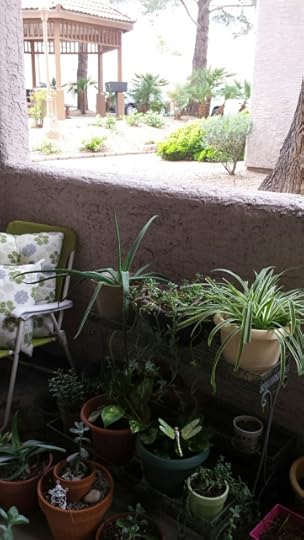
The view from my apartment patio. I love spending days out here during the spring drinking iced tea and reading on my Kindle.
This is a busy time of year for me. I have two weeks left of the Spring semester for my university learning and teaching, and I have final papers to write and final papers to grade. I’m also working on a newly edited version of Her Dear & Loving Husband to celebrate the novel’s 5th anniversary. I like to do some spring cleaning around the house this time of year, not just dusting behind bookcases where I’ll never see, but I like to weed through my wardrobe, my books, my shoes, and old appliances and donate things I don’t wear or use anymore to the Salvation Army. I’ve become interested in the minimalist movement, and I’ll have more to say about that in a later post.
As I’ve been thinking about my 2016 spring cleaning, I realized that my author website was something I had been sadly neglecting. I’ve said in this post how I learned that author websites should have a landing page to make for easier navigation for visitors, and while I never doubted the value of that advice, I liked having a flowing site where my latest posts were the first thing you’d see. It was simply my personal choice, and I was happy with it. But over the years I’ve learned and grown like everyone else, and I decided to make some changes to my author business this year. My website seemed a great place to start.
I should begin by saying that I loved the old site. I loved the Gothic feel, the color scheme, and I loved the clean look to it. Too many websites, from authors and others, hurt my aging eyes with the busyness of all those links, icons, and other doo-dahs. When I decided that my website needed a makeover, the first thing I realized is that I wanted to maintain clean lines while changing things up in a good way. My blog had looked exactly the same since I started it five years ago. It even had the same header—from the cover of Her Dear & Loving Husband—because when I first created the website that’s the only book I had published.
To make some much needed changes, I upgraded my blog theme to Hemingway Rewritten (of course the name Hemingway drew me in, but I think it’s a snazzy looking template anyway). Then I added several of my novels to the header so there’s more of a sense of the various books I’ve written. I simplified my tagline to just ‘Historical Fiction With a Twist.’ Simplicity–that was my keyword for the remodeling. I do, finally, have a landing page that acts as a directory for the site. The blog is still there (obviously, or you wouldn’t be subjected to reading this now), located conveniently in the handy-dandy Blog link in the menu at the top.
I consolidated the links to buy my books with the book descriptions to create one ‘Buy My Books’ page to make it easier for potential buyers to find the purchasing links. Her Dear & Loving Husband is free, but some new website visitors might not know that so I’ve made it easy for them to contact me with requests for the novel by clicking on the Free Book! link. I’ve also made it easy for new and existing Loving Husband Trilogy fans (you know who you are) to sign up for updates for Down Salem Way, which will be released Autumn 2016 (cross my heart).
Another major change I made was classifying my historical fiction into paranormal historical fiction (The Loving Husband Trilogy), Downton Abbey inspired historical fiction (When It Rained at Hembry Castle), Biblical historical fiction (Woman of Stones), Woman Suffrage and World War I historical fiction (Victory Garden), and American Civil War historical fiction (My Brother’s Battle). This way readers can see at a glance which of my historical novels might be of interest to them. The right sidebar has been cleaned up and now only contains social media links, my too-cool Indie Reader approved logo from IndieReader.com, and website sign up links.
It took me two full days to complete the website (that’s what happens when I’m procrastinating from writing a paper for school), but I’m happy with the final result. As much as I loved the old style, I wanted to make it as easy as possible for readers to navigate the site.
Over time I’ve learned that my author website is my online home, and I highly recommend one for all authors. We want to give our readers a designated place to find out more about our books, about us, and I’ve learned that the more personal we can be on our author websites, the more we can connect with our readers. I’ve said before that readers want to know who the man or woman is behind the curtain. Our author website gives us a way to share more of ourselves in a way that feels comfortable. If you’re new to my online home, welcome! If you’re a returning friend, I hope you like the redecorating.
Here’s to spring cleaning. You never know what undiscovered treasures you might find if you’re willing to open yourself up to trying out new things.
Filed under: News, Publishing Tagged: author websites, spring cleaning




